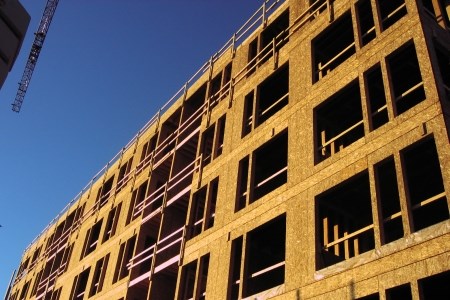The Canadian Wood Council wants Ontario wood used in the framing of mid-rise buildings.
The council and its Ontario WoodWORKS! arm are making a case for changes to the provincial building code to allow the construction of wood-framed buildings from five to eight storeys, otherwise known as mid-rises.
After talking with various experts and stakeholders in Ontario, they’ve released a report, “Wood solutions in mid-rise construction,” outlining some favourable findings on wood’s advantages, potential markets, cost comparisons and what wood technologies are out there.
The council wants to sway the Ministry of Municipal Affairs and Housing to remove a restrictive four-storey cap on wood frame construction when the industry consultations to make revisions to the building code take place later this year.
The Ontario Building Code was last amended in 2006.
“There’s no reason why it should have been capped at four storeys. Structurally, there’s no problem,” said Steven Street, a Guelph-based technical director with Ontario WoodWORKS!
“By allowing wood to compete in the five- to six-storey sector...there’s no lessening of the code provisions.”
Street said the ministry has been looking at a proposal to allow six-storey wood construction for a while, but he has no idea which direction they’re leaning.
The WoodWORKS! program promotes the use of wood in all types of construction by working with designers, engineers and contractors on projects.
But Street, who collaborated with consultant Jeff Walker on the report, said they entered this project with no preconceived bias of what the industry’s attitudes would be to working with wood.
After conducting 40 interviews with developers, architects, engineers and contractors various stakeholders, mainly in the Golden Horseshoe of southern Ontario, Street said they are very receptive to the idea of using wood for mid-rises.
“They’re chomping at the bit and ready to go,” said Street.
Eventually, the council wants to partner with private developers to construct a prototype building as a demonstration model.
They’re taking a page from a similar research project that began in Britain more than a decade ago.
The British Research Establishment headed a study that brought together researchers, industry and government regulators to test the safety, benefits and performance of a six-storey prototype light wood-framed building.
The United Kingdom now permits timber-framed, mid-rise buildings, has introduced harmonized building codes across the country and has produced a best practice construction guide.
If the code changes were made, Ontario’s battered and bruised forest industry could get a much-needed shot in the arm with a home-grown solution.
With the U.S. housing market still in the dumps, a change in regulations could create a new domestic market for Ontario wood producers and a construction growth spurt in new apartments, condominiums and social housing projects.
“We can invest in forestry but the important thing is to create the demand for lumber that comes from the processing at the mill end,” said Street.
Washingston State, Oregon and Minnesota are all exploring higher wood use with light wood-frame construction. Six-storey buildings are becoming commonplace on the West Coast as British Columbia’s code was amended in 2009 to permit them.
Street said the Ontario market and building code is much “more conservative” in construction, for whatever reason.
With timber-framed mid-rises being extensively studied elsewhere, Street felt compelled to investigate the markets and attitudes here.
Street said developers they’ve talked to are not willing to erect mid-rise steel and concrete buildings because it’s not cost effective for them to do so.
Wood is a cost-effective alternative. Findings show builders can save between 10 and 15 per cent by using wood building supplies.
Street said pre-fabricated wood structures go up much quicker, and a developer’s money isn’t tied up as long, thus creating more affordable housing.
“The numbers make sense.”
With Ontario’s population projected to rise more than 36 per cent by 2036, municipalities in southern Ontario will be under mounting pressure to infill their urban cores with a mix of new and affordable housing.
Street said that keeping the building code at status quo, with the four-storey cap, won’t alleviate the program.
There are obvious benefits with using wood as a sustainable material and its sturdy performance in earthquake zones.
Street said using wood is a cheaper alternative for municipalities in building more social housing projects, something that is sorely lagging in Ontario.
And mid-rise wood-framed buildings can be easily plunked into any downtown core or neighbourhood without destroying its character.
For a copy of the study, contact Steven Street at 1-866-886-3574 or e-mail him at sstreet@wood-works.ca




